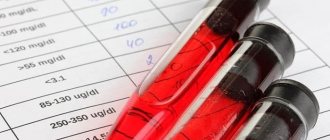Detailed description of the study
The main task of the immune system is to protect the body from pathogenic bacteria, viruses and other microorganisms both upon first contact with them and upon repeated contact.
Allergies occur when a person reacts to substances that are harmless to most people. These substances are known as allergens. They can be particles of dust, animal hair and dander, substances secreted by insects and mites, as well as mold and pollen. There is a large group of food allergens, among them reactions to wheat, honey, chocolate, and nuts are common.
All allergic reactions are preceded by an asymptomatic first encounter with an allergen, in which specific immunoglobulins of class E (IgE) have already been formed. When they meet again, IgE reacts with the allergy-provoking substance and causes the release of substances from the so-called mast cells (a type of immune cell) that contribute to the appearance of allergy symptoms.
Manifestations of this disease may be:
- Sneezing
- Nasal congestion, excessive discharge
- Inflammation of the eyes (allergic conjunctivitis)
- Itchy skin
- Skin redness, rashes (urticaria)
- Dry cough, wheezing when breathing
- Cramping abdominal pain, diarrhea
Various substances of plant and animal origin cause the development of allergies. By detecting specific IgE antibodies in the blood, allergens can be identified, which is important for preventing allergy symptoms.
The RIDA immunoblot is a panel containing 20 allergens. It is highly likely to identify substances that provoke allergies.
Test composition:
- Derm mite, pteronyssinus
- Derm mite, farinae
- Alder (pollen)
- Birch (pollen)
- Hazel (pollen)
- Herbal mixture (pollen)
- Rye (pollen)
- Wormwood (pollen)
- Plantain (pollen)
- Cat
- Horse
- Dog
- Alternaria alternata
- Egg white
- Milk
- Peanut
- Hazelnut
- Carrot
- Wheat flour
- Soya beans
Immunoblot of antiphospholipid antibodies, IgG and IgM
Immunoblot of antiphospholipid antibodies is an immunological study that allows, in one laboratory test, to analyze several autoantibodies associated with the development of antiphospholipid syndrome.
Synonyms Russian
Immunoblotting.
English synonyms
APS Immunoblotting, Antiphospholipid Antibodies Assay, Western Blot Analysis for the detection of Antiphospholipid Syndrome.
What biomaterial can be used for research?
Venous blood.
How to properly prepare for research?
- Do not smoke for 30 minutes before the test.
General information about the study
Antiphospholipid syndrome is an autoimmune disease clinically characterized by arterial and venous thrombosis, obstetric pathology (primarily recurrent miscarriage in the first and second trimesters and premature birth), thrombocytopenia and associated with the circulation of antiphospholipid antibodies in the blood.
Antiphospholipid antibodies are not only a laboratory marker of APS, but also play a leading role in the pathogenesis of its clinical manifestations. APLA have the ability to influence the processes that form the basis of the regulation of the blood coagulation system, shifting the balance in it towards hypercoagulation - that is, thrombus formation. The process of thrombus formation involves the interaction of APLA with phospholipids of the membranes of platelets, endothelium (cells lining the inside of blood vessels) and plasma proteins associated with phospholipids. In APS, vessels of any caliber can potentially be affected - from the capillary bed to large arteries, which causes an extremely diverse range of clinical manifestations of the disease.
Antiphospholipid antibodies are a family of immunoglobulins of different classes (IgA, IgM and IgG) that recognize specific regions of phospholipid molecules. However, according to recent studies, it turned out that the main targets of APLA are not the phospholipids themselves, but the plasma proteins that bind to them, the so-called cofactors. The cofactor-phospholipid complex forms a new molecular sequence to which specific antibodies are produced.
Thus, APLA react with a heterogeneous group of phospholipids and protein antigens in blood plasma, which include:
- phospholipids - cardiolipin, phosphatidylserine, phosphatidylinositol, phosphatidylethanolamine, phosphatidylcholine and phosphatidylic acid;
- plasma proteins - “cofactors” - β2-glycoprotein I, prothrombin, thrombin, protein S, protein C, annexin V.
The increased risk of developing myocardial infarction against the background of APS was confirmed after the discovery in the spectrum of APLA of antibodies to oxidized low-density lipoproteins, which play a leading role in the pathogenesis of atherosclerosis.
The currently used diagnostic criteria for antiphospholipid syndrome, adopted in 2006 in Sydney, in addition to two clinical parameters (thrombosis and obstetric pathology), also include three laboratory signs - lupus anticoagulant (determined in phospholipid-dependent blood clotting tests), as well as antibodies to cardiolipin and antibodies to β2-glycoprotein I classes IgM and IgG, determined by enzyme immunoassay.
- Antibodies to cardiolipin are the main fraction of APLA, their presence is usually associated with the development of thrombosis and thrombocytopenia. Detection of an increased titer of antibodies to cardiolipin against the background of a clinical picture of thrombosis is the basis for making a diagnosis of APS.
- Antibodies to β 2- glycoprotein I. β2-glycoprotein I is a serum protein with natural anticoagulant activity. Circulating APLA recognize antigenic structures formed by the interaction of β2-glycoprotein I and cardiolipin. Antibodies to cardiolipin and β2-glycoprotein I are more often found in patients with the primary form of APS, and their clinical picture is dominated by deep vein thrombosis and pulmonary embolism.
Despite their high specificity, using only these laboratory criteria to diagnose APS is not always sufficient - the tests may be negative in the presence of clinical manifestations of antiphospholipid syndrome. Therefore, if a patient has symptoms of APS and negative results of criterion laboratory parameters, the determination of antibodies to other phospholipids) and cofactor proteins is additionally used.
- Antibodies to annexin V. The role of annexin V is especially important in preventing thrombus formation in the blood vessels of the placenta. This block is present in many tissues, but mainly on endothelial cells and in the placenta. Annexin V plays a role in preventing blood clotting by competing with prothrombin (a blood clotting factor) for binding to phosphatidylserine on the membrane of endothelial and trophoblast cells. Annexin V molecules form a blocking layer, and thrombus formation does not occur on the surface of the trophoblast. In patients with APS, antibodies to this protein displace it from the surface of endothelial cells and trophoblast cells, which leads to thrombosis of the placental vessels and loss of pregnancy. Antibodies to annexin V are more often detected in secondary antiphospholipid syndrome (occurring against the background of other autoimmune diseases); therefore, recurrent miscarriage syndrome is more common in the clinical picture of such patients.
- Antibodies to prothrombin. The presence of these antibodies is one of the main causes of thrombosis, primarily venous. In patients with APS, elevated levels of IgM antibodies to prothrombin are detected in approximately 30%, and IgG in 18% of cases.
- Antibodies to thrombin are one of the most sensitive tests for diagnosing antiphospholipid syndrome. The presence of these antibodies is associated with the development of thromboembolic complications in approximately 70% of cases - this is the highest rate among all APS markers.
To study a wide range of antiphospholipid antibodies, the immunoblotting method is used. It is based on the immunological interaction of an antibody with a specific antigen. Immunoblot test systems produced by the manufacturer contain nitrocellulose strips on which antigens of phospholipids and cofactor proteins are fixed. The test serum is applied to the strip; if it contains APLA, they each bind to their own antigen. Visualization of the formed immune complexes is carried out by adding a special enzyme and dye. If there are antiphospholipid antibodies in the serum, colored stripes will appear on the strip in areas corresponding to individual antigens - this is how a positive result is recorded. The color intensity of the band can be additionally described by the number of pluses - this indirectly reflects the concentration and affinity (degree of affinity) of the antibodies.
What is the research used for?
- To detect autoantibodies belonging to the AFLA family in the patient’s blood.
When is the study scheduled?
- If the clinical picture does not correspond to negative test results recommended by the Sydney laboratory criteria for APS (lupus anticoagulant, IgM and IgG antibodies to cardiolipin and β2-glycoprotein I).
What do the results mean?
Reference values
| Component | Reference values, Unit OP |
| IgG antibodies to cardiolipin | 0 — 30 |
| IgM antibodies to cardiolipin | 0 — 30 |
| IgG antibodies to phosphatidic acid | 0 — 30 |
| IgM antibodies to phosphatidic acid | 0 — 30 |
| IgG antibodies to phosphatidylcholine | 0 — 30 |
| Antibodies to phosphatidylcholine IgM class | 0 — 30 |
| IgG antibodies to phosphatidylethanolamine | 0 — 30 |
| IgM antibodies to phosphatidylethanolamine | 0 — 30 |
| IgG antibodies to phosphatidylglycerol | 0 — 30 |
| Antibodies to phosphatidylglycerol IgM class | 0 — 30 |
| IgG phosphatidylinositol antibodies | 0 — 30 |
| IgM antibodies to phosphatidylinositol | 0 — 30 |
| IgG antibodies to phosphatidylserine | 0 — 30 |
| Antibodies to phosphatidylserine class IgM | 0 — 30 |
| Annexin V IgG antibodies | 0 — 30 |
| Antibodies to annexin V class IgM | 0 — 30 |
| Antibodies to beta-2 glycoprotein IgG class | 0 — 30 |
| Antibodies to beta-2 glycoprotein IgM class | 0 — 30 |
| IgG antibodies to prothrombin | 0 — 30 |
| Antibodies to prothrombin IgM class | 0 — 30 |
Immune blotting is a qualitative test and provides a “detected” or “not detected” response. The detection of APLA supports the diagnosis of antiphospholipid syndrome, however, positive results should be assessed only in conjunction with the clinical picture.
What can influence the result?
About 5% of healthy people have an elevated APLA titer, most often these are elderly people - with age, the percentage of APLA-positive people who do not suffer from APS increases. The frequency of detection of antiphospholipid antibodies also increases in patients with inflammatory, autoimmune and infectious diseases (syphilis, HIV infection, hepatitis C viral infection, herpes viral infection), malignant neoplasms, as well as while taking certain medications (psychotropic drugs, oral contraceptives). Thus, any of the laboratory signs in the absence of clinical symptoms is not a sufficient condition for diagnosing APS.
Important Notes
In addition to the primary antiphospholipid syndrome, there is also a secondary one that occurs against the background of other connective tissue diseases. Moreover, in some patients, the appearance of signs of APS may precede the appearance of symptoms of a primary connective tissue disease (systemic lupus erythematosus, periarteritis nodosa, systemic scleroderma, rheumatoid arthritis). Therefore, when examining patients with suspected APS, the diagnostic program should include the determination of antinuclear factor as a screening test.
Also recommended
- Antibodies to cardiolipin, IgG and IgM
- Antibodies to β2-glycoprotein I, IgG and IgM
- Lupus anticoagulant
- Antinuclear factor
Who orders the study?
Hematologist, rheumatologist, obstetrician-gynecologist, angiosurgeon, pulmonologist, therapist, general practitioner.
Literature
- A Manual of Laboratory and Diagnostic Tests, 9th Edition, by Frances Fischbach, Marshall B. Dunning III. Wolters Kluwer Health, 2015. Page 609.
- Henry's Clinical Diagnosis and Management by Laboratory Methods, 23e by Richard A. McPherson MD MSc (Author), Matthew R. Pincus MD PhD (Author). St. Louis, Missouri: Elsevier, 2021. Page1014.
- Clinical laboratory diagnostics: national guidelines: in 2 volumes - T. II / Ed. V. V. Dolgova, V. V. Menshikova. – M.: GEOTAR-Media, 2012. P. 96-99, 150-154.
Interpretation of analysis results (for specialists!*)
Uremia may lead to a false negative result. Increase reference values: procainamide, disopyramide, propafenone, some ACE inhibitors, beta blockers, hydralazine, propylthiouracil, chlorpromazine, lithium, carbamazepine, phenytoin, isoniazid, minocycline, hydrochlorothiazide, lovastatin, simvastatin.
Interpretation of results:
Increasing reference values: systemic lupus erythematosus; autoimmune pancreatitis; autoimmune thyroid diseases; malignant neoplasms of the liver and lungs; polymyositis/dermatomyositis; autoimmune hepatitis; mixed connective tissue disease; myasthenia gravis; diffuse interstitial fibrosis; Raynaud's syndrome; rheumatoid arthritis; systemic scleroderma; Sjögren's syndrome.
Reduction of reference values: Absence of systemic connective tissue disease.
To interpret the study results, contact your doctor!
Reference values (norm)
* Interpretation of the results is intended for your attending physician, who will determine an accurate diagnosis and prescribe a treatment regimen, taking into account the results of not only this analysis, but also the entire range of studies for your specific case. Do not diagnose yourself - be sure to consult a doctor!





